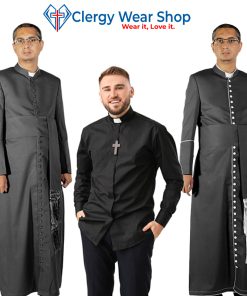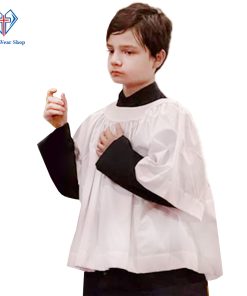Clergy Robes for Men
The Complete Guide to Priest Outfit Name
Priest Outfit Name are relevent to the vestments, are more than just what priests, pastors, bishops wear. These garments have been part of church traditions for hundreds of years and hold important meanings that connect people to their faith and history. Some outfits look fancy, while others are simpler, but each piece has a purpose and tells a story.
When you see a Catholic priest, their outfit isn’t just clothing it’s a symbol of their faith, mission, and role in the church. Priestly garments are rich in tradition and meaning, and each piece has its own significance.
In this guide, we’ll explore the priest outfit name and parts of priest outfits, their variations across denominations, and where you can purchase or craft these iconic garments.
It can be a bit confusing to understand what each piece is called and why it’s important. If you’ve ever wondered why priests wear these special clothes and what they mean, you’re in the right place!
Let’s explore the history and meaning behind these garments and learn how they add to the worship experience.
What Is a Priest’s Outfit Called?
The outfit a priest wears is traditionally referred to as clerical attire. This Guide to Priest Outfits includes several pieces, each with unique purposes and meanings. For Catholic priests, the primary garment is the cassock or alb, complemented by liturgical vestments during Mass.
The outfit a priest wears is commonly referred to as a cassock, alb, or vestments, depending on its specific use and tradition. Each piece of clerical attire has its distinct name and purpose, often rooted in centuries-old traditions.
Priest Outfit Names
The priest outfit name, the cassock, is a long robe symbolizing devotion, often black for priests and colorful for higher clergy. Additional garments like the alb, stole, and chasuble during liturgical ceremonies emphasize their spiritual role and authority.
- Cassock: A long, close-fitting robe worn as everyday attire or under liturgical vestments.
- Alb: A white garment symbolizing purity, typically worn during liturgical ceremonies.
- Vestments: A general term for the ceremonial garments worn during religious services, including the chasuble, stole, and dalmatic.
- Clerical Suit: A modern outfit consisting of a black suit and clerical shirt with a tab or Roman collar.
These garments are designed to reflect humility, service, and reverence for their sacred duties.
Parts of a Priest’s Outfit
A priest’s outfit consists of multiple layers, each carrying its own symbolism. Here’s a breakdown of Guide to priest outfit name:
- Cassock:
The long, close-fitting robe is the foundation of clerical attire. It can be black, white, or red, depending on the priest’s rank or the occasion. - Alb:
A white, ankle-length garment symbolizing purity, worn under the chasuble during Mass. - Chasuble:
The outermost vestment used during liturgical services, often adorned with intricate embroidery or symbols. - Stole:
A narrow, scarf-like garment draped around the shoulders, symbolizing the priest’s authority and service. - Cincture:
A rope belt used to secure the alb, symbolizing chastity. - Amice (optional):
A square piece of cloth covering the shoulders and neck, often used to protect the outer vestments. - Surplice:
A loose-fitting white garment with wide sleeves, often worn over the cassock during non-Eucharistic services.
Different Types of Priest Outfits
Priestly garments vary based on denomination, liturgical season, and ceremonial needs.
- Catholic Priest Uniform:
Includes the cassock, alb, and chasuble, often paired with accessories like the biretta (a traditional cap). - Anglican Priest Uniform:
Similar to Catholic attire but may incorporate regional influences, such as unique colors or patterns in the chasuble. - Jesuit Priest Uniform:
Known for its simplicity, often consisting of a plain black cassock. - High Priest Uniform:
In biblical references, this includes ornate garments with symbolic designs, such as breastplates and ephods.
Priest Suits: A Modern Adaptation
While traditional robes dominate clerical attire, the priest suit is a modern and versatile alternative.
What Is a Priest Suit?
A priest suit combines a standard suit with a clerical shirt featuring a tab or Roman collar. It is a practical and professional option for non-liturgical duties, meetings, and public appearances.
Priest Collar Suit
The priest collar suit blends the simplicity of modern suits with the iconic clerical collar. It is favored for its balance of formality and functionality.
Catholic Priest Suit
Catholic clergy often choose suits for everyday wear in Western contexts, adhering to tradition while adapting to modern norms.
Priest on Suits: A Symbol of Relevance
The image of a priest on suits represents the church’s adaptability in contemporary society, maintaining spiritual identity while engaging with the modern world.
Crafting Clerical Clothes
For those who wish to add a personal touch, crafting clerical clothes is an art that requires attention to tradition. Many priests choose bespoke garments tailored to fit perfectly, ensuring comfort and dignity during long services.
Fabrics like linen, wool, and silk are common for their durability and elegance.
Where to Buy Priest Outfits
If you’re wondering where to buy a priest outfit, specialized stores are catering to clerical needs. Online platforms like Clergy Wear Shop offer various garments for priests, pastors, and other clergy members.
These stores provide Guide to Priest Outfits options for ready-to-wear and custom-made outfits, ensuring quality and tradition are upheld.
The Symbolism Behind Priestly Attire
Every part of a priest’s outfit holds spiritual significance:
- The alb represents purity.
- The stole signifies authority and responsibility.
- The cincture embodies purity and self-restraint.
These elements remind both the priest and the congregation of the sacred responsibilities tied to the clerical role.
Conclusion
The attire of priests, from traditional cassocks to modern clerical suits, profoundly represents their spiritual calling and dedication to their faith. Each piece, whether a chasuble worn during Mass or a clerical collar in a formal setting, carries historical, symbolic, and practical significance.
The evolution of priestly attire, including the adoption of priest suits, highlights the Church’s ability to honor tradition while adapting to contemporary contexts.
Whether you’re exploring priestly garments for their religious meaning, historical roots, or modern interpretations, understanding their purpose and symbolism deepens appreciation for the role of clergy in faith communities.
For high-quality clerical attire, including cassocks, albs, stoles, and priest suits, visit Clergy Wear Shop, where tradition meets excellence. If you have further questions about clerical attire or its significance, the FAQs above offer quick answers to common queries.
Frequently Asked Questions
What is a priest’s outfit called?
A priest’s outfit is generally called clerical attire, with the cassock or alb being the primary garments.
What are the parts of a Catholic priest’s outfit?
The main parts include the cassock, alb, cincture, stole, chasuble, and sometimes an amice or surplice.
Where can I buy a priest outfit?
Specialized stores like Clergy Wear Shop offer a variety of clerical garments for different occasions.
What is the difference between Anglican and Catholic priest outfits?
Anglican attire is similar to Catholic garments but may feature regional variations in colors or patterns.
Can clerical clothes be custom-made?
Yes, many priests prefer tailored outfits to ensure a perfect fit and alignment with their preferences.
What is the outfit a Catholic priest wears called?
A Catholic priest typically wears a cassock or vestments, depending on the occasion.

 Clergy Cassocks for Men
Clergy Cassocks for Men Clergy Cassocks for Women
Clergy Cassocks for Women Clergy Robes for Women
Clergy Robes for Women Clergy Shirts for Men
Clergy Shirts for Men Clergy Shirts for Women
Clergy Shirts for Women






